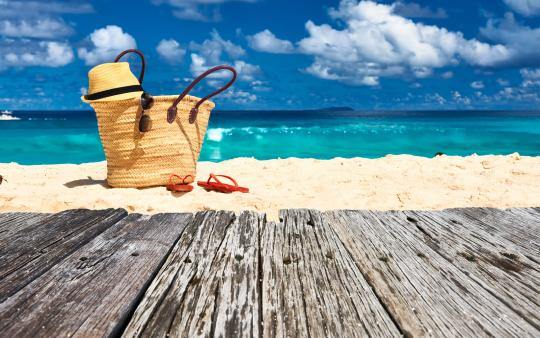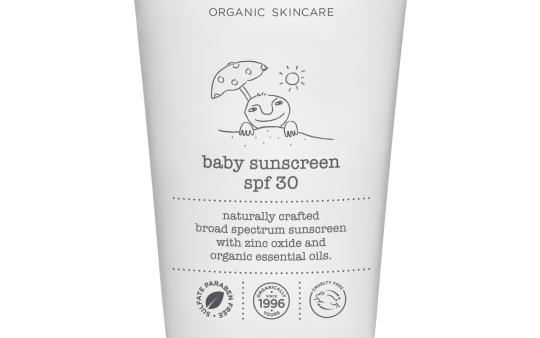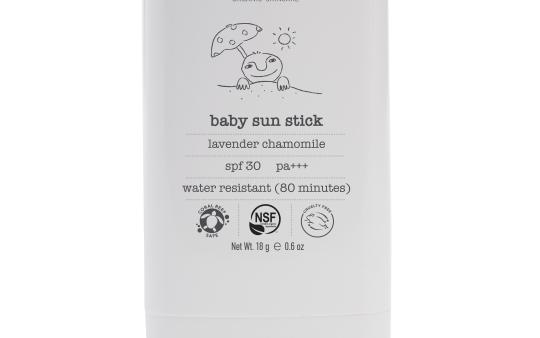As grown ups, we totally get the need for sun protection. Our aim is simple: protect our kiddos perfectly perfect skin from those harmful UV rays and from the threat of that dreaded sunburn. We’ll make sure our kids don sunglasses, hats, and wear rash guards at the beach. We’ll keep them out of the sun between the hours of 10 am and 2 pm, and we’ll do our best to make sure they’re lathered up with sunscreen.
Proper sunscreen use and application has become an essential part of enjoying the great outdoors, especially when you’re soaking in those glorious sunshiny rays. It can be tempting to grab those misting sprays of sunblock protection that promise to dry instantly and be waterproof, sweatproof, and offer a kajillion SPF protection. But those seemingly perfect sunscreens typically contain chemicals and toxins that are the exact opposite of the protection they promise to provide.
Go into any drugstore, and there will be an entire aisle dedicated to sun care. It can be pretty overwhelming. So what’s a parent to do?
What to look for in a sunscreen
Navigating the sunscreen aisle shouldn’t take a degree in biochemistry. A great sunscreen should be mineral-based, meaning it contains either zinc oxide, titanium oxide or, both. These minerals act as a sun deflector. They sit on top of the skin instead of being absorbed, which gets those short wave UVA rays before they hit the skin! Sure, the trade off is a sunscreen that goes on a little whiter, and may be a bit greaser than those conventional sunscreens, but the lack of carcinogens and harmful toxins is well worth a moment or two of extra rubbing.
Most conventional sunscreens use chemicals as a way to filter UV rays. They also use other chemicals that help sunscreen stick to skin. All these chemicals get absorbed into the skin and can actually be measured in our blood!
A sunscreen shouldn’t contain ingredients that you can’t pronounce or understand. Steer clear of phthalates, parabens, oxybenzone, and octinoxate. Basically, if a product promises to be “waterproof” or “sweatproof”, you can safely assume that they’re using chemicals to filter the UV rays.
Safe sunscreen for all your parts!
Natural sunscreens have come a long way. New formulations glide on smoothly, smell amazing, and last as long as conventional sunscreens. They come in a variety of options from creams, to sticks, to lip balms and even continuous spray. And they all have something in common: mineral-based products that block both UVA and UVB rays with ingredient lists that make parents feel good. Check out these options for better sunscreen that won't leave you feeling toxic!

Goddess Garden
Goddess Garden was recognized again by EWG as one of the best-scoring kids’ sunscreens of 2019. These mineral-based and certified organic family staples are available in creams, sticks, and continuous sprays, which use compressed air as a propellant (vs. flammable chemicals typically used in conventional sunscreen sprays).
Green Beaver
Don’t forget about those lips! Green Beaver has a great organic mineral-based sunscreen lip balm (SPF 15) perfect for life on the go and also carries a line of organic, mineral-based organic sunscreens for both kids and grown-ups!

Matter Company
Matter Company’s Substance Baby Sun Care (SPF 30) line not only smells lovely, it also relies on luxurious skin-loving ingredients like shea butter, jojoba, and sesame oil for added protection! Made with organic ingredients, Substance uses only non-nano zinc. Grab either their sun care creme and baby sun care stick or go totally unscented!

Thinkbaby
Featured as one of EWGs best scoring sunscreens for 2019, Thinkbaby offers mineral-based sunscreen with a 50 SPF. This easy to apply mineral-based sunscreen is available in both a sunscreen cream and a stick. Best of all it smells like sweet papaya: a tribute to summers everywhere!

Dr. Fedorenko
Who can resist a sunscreen in a paper tube? Dr. Fedorenko’s True Organic Skin Stick (SPF 30) is reef-safe, and is full of skin-saving organic ingredients like sea buckthorn, tamanu, avocado, and red raspberry seed oils! EWG-verified and ready to tote wherever you go!

Earth Mama Organics
Got a kiddo with super sensitive, rash-prone skin? Earth Mama Organics has got the sunscreen for you! Their Kids Uber-Sensitive Mineral Sunscreen Lotion is SPF 40 and delivers big on protection and even bigger on soothing skin by integrating tons of organic colloidal oatmeal and shea butter in their sunscreen! Reef-friendly, non-nano zinc, it’s also been chosen as one of EWG’s best scoring kids’ sunscreens for 2019!
Erbaviva
Keep that baby skin baby-perfect with Erbaviva’s Baby Sunscreen (SPF 30) and Baby Sun Stick (SPF 30). Reef-safe and organically crafted with aloe, sunflower, and jojoba oils with touches of chamomile and lavender, it’s gentle enough for the whole family: from the smallest babies to the biggest kids!

LASPA
Feel good about slathering up with LASPA Moisturizing Mineral Sunscreen (SPF 30)! This reef safe, mineral-based sunscreen is made with certified organic ingredients and is perfect for sensitive skin. For a little extra coverage use the SPF 30 in conjunction with LASPA’s SPF 50 Ultra Sun Protection Stick for those super-exposed areas like the tops of your ears and nose!

Sunblocz
Want a product that minimizes the ghastly white of zinc while still enjoying the benefits of a mineral-based sunscreen? Sunblocz’s unique tinted sunscreen does just that, thanks to iron oxides that give the sunscreen a beige-ish hue and helps to minimize some of that whitish glow that plagues zinc wearers! Available as well in a non-tinted white for kids (so you can make sure every inch of their exposed skin is covered!) this EWG best scoring sunscreen of 2019 features non-nano zinc oxide and a host of nourishing oils (plus a dash of lavender and rosemary!).
Whichever sunscreen you choose for your little ones, it's important to pick one that's made of ingredients whose names you can pronounce and components you feel good about!
5 safer sun tips for kids (and grown-ups!)
- Keep kids out of direct sunlight during the most intense hours of the day (usually from 10 am to 2 pm).
- Make sure your child has a sun hat, as well as sun clothes. Light-coloured, lightweight fabrics can serve as natural sun protection as can long sleeved rash guards.
- Babies under six months of age should not wear sunscreen.
- Choose sunscreens that have a mineral sunblock and use natural minerals like zinc oxide and titanium oxide that block and deflect the suns rays.
- Sunscreen needs to be reapplied. Follow the directions on the back of the package. A good rule of thumb though is to reapply after swimming or getting wet (including sweating).











